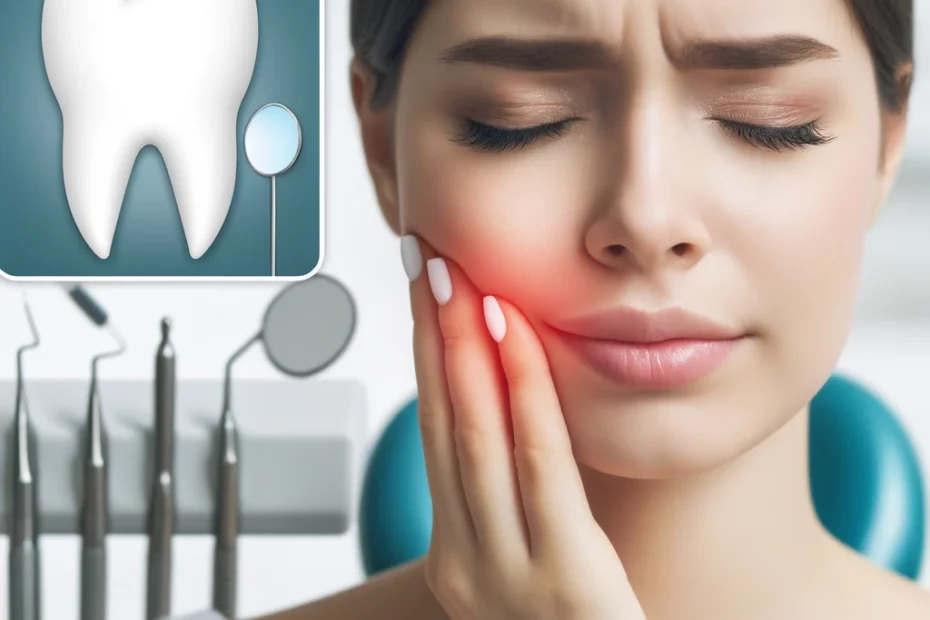Experiencing pain after a dental filling can be disconcerting, especially when you expect immediate relief. This discomfort can disrupt daily activities, making eating, drinking, or speaking difficult. Understanding the reasons behind this pain is crucial for peace of mind and proper dental care.
Let’s delve into post-filling pain, its causes, types, and management, ensuring you can address the issue effectively and return to your normal routine swiftly. Identifying and managing this pain can prevent further complications, save you from additional dental visits, and ensure long-term oral health.
Understanding Dental Fillings
Dental fillings are a common procedure to restore teeth damaged by decay. They involve removing the decayed portion of the tooth and filling the cavity with a suitable material. While this process aims to alleviate pain and prevent further decay, some patients experience discomfort afterward.
Common Causes of Post-Filling Pain
Several factors can contribute to pain after a dental filling.
- One primary cause is the presence of high spots on the filling, which can lead to premature contact with the opposing teeth during biting. This uneven pressure can result in significant discomfort as the high spot forces the tooth into an unnatural position, causing stress on the surrounding structures.
- Another common cause is the irritation of the tooth’s nerve during the procedure. Removing decay and preparing the tooth for the filling can be traumatic to the delicate nerve tissues inside the tooth. This irritation can lead to temporary pain that typically subsides as the nerve heals.
- Sometimes, the filling might be placed too close to the nerve. When the decay is extensive and deepens into the tooth, the filling material may end up near the nerve, causing prolonged sensitivity. This discomfort can persist for weeks and may require additional dental intervention if it does not improve.
- Also, micro-leakages can occur if the filling is not adequately bonded to the tooth. These tiny gaps allow bacteria and fluids to seep in, irritating the nerve and leading to pain and sensitivity.
- Furthermore, some dental materials used in fillings can change temperature, exacerbating sensitivity when consuming hot or cold foods and drinks.
Types of Pain Experienced After Fillings
Post-filling pain can manifest in various forms, each indicating different underlying issues.
One common type is sharp pain when biting down. This pain often suggests that the filling is too high, causing an uneven bite. The pressure from the high spot forces the tooth to bear more force than it can handle, leading to sharp, shooting pains.
Throbbing pain, especially if persistent, could indicate nerve involvement or an infection. When the nerve inside the tooth is significantly irritated or damaged during the filling procedure, it can lead to a throbbing pain that doesn’t subside easily. This type of pain can also be a sign of pulpitis, an inflammation of the tooth pulp, which may require further treatment such as a root canal.
Sensitivity to hot and cold stimuli is also common after a filling. This sensitivity typically occurs due to the changes in the tooth structure and the materials used for the filling. For example, amalgam fillings can expand and contract with temperature changes, leading to discomfort. Composite fillings, while less prone to temperature-related expansion, can still cause sensitivity if not properly bonded or cured.
In some cases, patients may experience a dull, aching pain that lasts for an extended period. This type of pain might indicate a deeper issue such as an improperly placed filling, where the edges are not sealed correctly, allowing bacteria to enter and cause further decay or infection.
It’s also important to recognize that different patients have varying thresholds for pain and sensitivity. Some individuals might experience significant discomfort with even minor issues, while others may only notice severe problems.
Monitoring the duration and intensity of the pain is crucial for determining whether it is a normal part of the healing process or if it requires professional intervention.
The Role of Dental Materials in Post-Filling Pain
The choice of filling material plays a significant role in post-filling pain. Different materials interact with the tooth and surrounding tissues in various ways, leading to differing comfort levels or discomfort.
- Amalgam fillings, composed of a mixture of metals including silver, mercury, copper, and tin, have been used for over a century due to their durability and strength. However, one of the downsides of amalgam is its tendency to expand and contract with temperature changes. This thermal expansion can cause the filled tooth to exert pressure on the surrounding structures, leading to discomfort or pain. Additionally, the metallic nature of amalgam can sometimes create a galvanic reaction when it comes into contact with other metals in the mouth, resulting in a mild electric shock sensation.
- Composite resins, made from a mixture of plastic and fine glass particles, are favored for their aesthetic advantages as they can be closely matched to the natural color of teeth. However, composites require precise handling and curing. If the composite is not properly cured, meaning it is not fully hardened using a special light, it can lead to incomplete bonding with the tooth structure. This improper bonding can result in sensitivity and discomfort as the tooth is not adequately protected from external stimuli. Furthermore, composites can shrink slightly during curing, potentially creating small gaps between the filling and the tooth, which can harbor bacteria and cause further irritation or decay.
- Glass ionomer and resin ionomer fillings, though less commonly used for large cavities, also contribute to post-filling pain. These materials release fluoride, which helps prevent further decay, but they can be less durable and more prone to wear and tear. The initial setting phase of these materials can also be sensitive to moisture, affecting their long-term stability and potentially leading to sensitivity if not handled correctly.
- Although gold fillings are rare due to their cost, they offer excellent durability and biocompatibility. Gold does not corrode and is well-tolerated by gum tissues, but its thermal conductivity can cause sensitivity to temperature changes if the underlying tooth structure is not well-insulated.
Sensitivity Versus Pain: Knowing the Difference
Distinguishing between sensitivity and pain is crucial for proper diagnosis and treatment. Sensitivity usually manifests as a mild, temporary discomfort triggered by hot, cold, or sweet foods. This type of discomfort typically occurs immediately upon exposure to the stimulus and subsides quickly once the stimulus is removed.
Pain, on the other hand, is often more intense and persistent, indicating a deeper issue that may require professional attention. Pain can be spontaneous or triggered by biting and is typically not confined to a brief moment. Persistent pain might indicate nerve involvement, infection, or an improperly placed filling.
- For example, if the filling is too high and interferes with the bite, it can cause continuous pressure and pain.
- Similarly, if the decay was extensive and close to the nerve, the filling might not fully protect the nerve, leading to prolonged pain and discomfort.
Sometimes, what starts as sensitivity can evolve into pain if left unaddressed. For instance, if a poorly bonded filling allows bacteria to infiltrate, it can lead to decay beneath the filling and eventually cause pain. Therefore, understanding and accurately describing the discomfort’s nature can help diagnose the underlying problem and determine the appropriate treatment.
Managing Pain After a Filling
Managing post-filling pain involves several strategies:
- Over-the-Counter Pain Relievers: Non-prescription analgesics such as ibuprofen or acetaminophen can effectively alleviate mild to moderate pain and inflammation associated with dental procedures.
- Avoiding Hard or Sticky Foods: Hard foods like nuts and sticky substances like caramel can put undue stress on the newly filled tooth, potentially dislodging the filling or causing further irritation. Opt for softer foods until the pain subsides.
- Chewing on the Opposite Side: To minimize pressure and avoid aggravating the filled tooth, chew food on the opposite side of your mouth. This can help the affected tooth heal without additional strain.
- Avoiding Extreme Temperatures: Consuming foods and beverages at moderate temperatures can prevent sensitivity spikes. Avoid very hot or cold items that can exacerbate discomfort.
- Applying a Cold Compress: If swelling accompanies the pain, applying a cold compress to the outside of the cheek can help reduce inflammation and numb the area, providing relief.
When to Seek Professional Help
While some discomfort is normal, certain signs warrant a visit to the dentist. Persistent pain lasting more than a few days, severe sensitivity, or swelling around the tooth could indicate complications such as a misaligned filling, nerve damage, or an infection that requires prompt attention.
Preventive Measures to Avoid Post-Filling Pain
Preventive care is essential to minimize the risk of post-filling pain:
- Regular Dental Check-Ups: Frequent visits to the dentist allow for early detection and treatment of cavities, reducing the need for extensive and potentially painful fillings.
- Good Oral Hygiene Practices: Brushing at least twice daily with fluoride toothpaste and flossing daily helps remove plaque and prevent tooth decay. Proper technique and consistency are key.
- Using Fluoride Treatments: Fluoride helps strengthen enamel and makes teeth more resistant to decay. Consider fluoride treatments or fluoride mouthwash as part of your oral care routine.
- Eating a Balanced Diet: A diet rich in vitamins and minerals supports oral health. Avoid excessive sugary foods and drinks that can lead to cavities.
- Avoiding Tobacco Products: Smoking and other tobacco use can contribute to gum disease and tooth decay, increasing the likelihood of needing fillings and experiencing related pain.
- Wearing Mouthguards: If you grind your teeth at night or play contact sports, wearing a mouthguard can protect your teeth from damage that might require fillings.
- Addressing Small Cavities Promptly: Treating small cavities early prevents them from growing larger and requiring more extensive fillings, which can be more painful.
Implementing these strategies and preventive measures can significantly reduce the risk of experiencing pain after a filling and help maintain overall dental health.
Conclusion
While not uncommon, pain after a dental filling can be managed effectively with the right knowledge and care. Understanding the causes, types, and management of post-filling pain empowers patients to seek appropriate solutions and maintain optimal oral health. Regular dental visits and hygiene practices remain key to preventing dental issues and ensuring a pain-free smile.

Dr. Orion Johnson is a dedicated and compassionate dentist committed to providing exceptional dental care to his patients.Dr. Johnson obtained his Doctor of Dental Surgery (DDS) degree from a prestigious dental school, where he excelled academically and clinically. He is licensed to practice dentistry and stays updated with the technology through continuing education and training.

